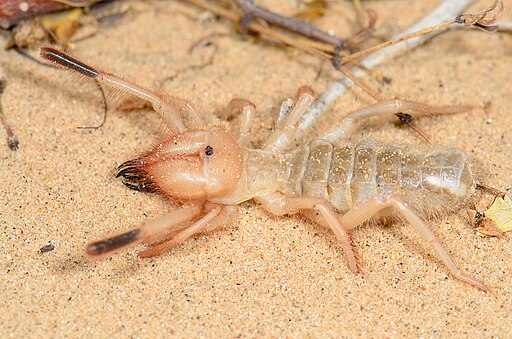Camel Spider
(Solifugids)
What are solidugids?
Solifugids are neither spiders nor scorpions. They are also not insects. They look like a cross between a spider, a scorpion, and an insect, and they are closely related to all three. Like spiders and scorpions, solifugids are arachnids, but are grouped into their own separate order called Solifugae.
What do solifugids look like?
Solifugids are usually light grey, tan or reddish-brown in color. Their body lengths range from ½ to 4 inches (1-10 cm), not counting outstretched legs. They are spider-like in shape with a bulbous, segmented abdomen (hind portion of body). The legs and body are covered with long hairs that glisten in the sunlight. They may appear to have ten legs, but upon closer inspection, the front legs are not legs at all, but a different kind of appendage, called pedipalps. These pedipalps are sticky on the end to help catch and hold prey, and this also gives them the ability to climb smooth surfaces such as glass. Like spiders, solifugids have eight legs, but they only use the back six for walking and running. The front pair of legs, held out in front and over their heads, are used like antennae to feel where they are going. The most noticeable feature of solifugids are their large paired jaws (chelicerae). Each chelicera works like a combination pliers/knife tool, used to grab and crush prey, then worked with a sawing motion to chew prey into pulp.
Where do solifugids live?
There are over 1,000 different species of solifugids. Most are found in the hot desert regions of the world. To escape the daytime heat, solifugids retreat to areas under rocks, logs and other debris or burrow into the sand or soil. Some species are active only during the daytime, while others are active only at night.
Are solifugids dangerous to humans?
Although solifugids seem fierce and intimidating, they are generally harmless creatures toward humans. Solifugids do not have any venom glands. They rely on their strong jaws and speed to avoid enemies and catch prey. However, solifugids are very aggressive, and they can inflict a painful bite if cornered or handled. The larger species can easily puncture and tear human skin tissue, and secondary infections may occur at the bite site. In a way, solifugids are helpful to humans, since their diet includes many types of venomous insects, spiders, scorpions and centipedes.
How can I avoid being bitten by a solifugid?
- Look before you reach into, under, over or around!
- Don't try to pick one up.
- Eliminate as many of the hiding places as possible for solifugids and their prey.
- Sandbag around the edges of tents in order to seal entry gaps.
- Always shake out shoes, sleeping bags, and clothing before you use them.
- Never walk barefoot; wear shoes or boots (avoid open-toed footwear) when walking outdoors.
- If possible, avoid sleeping on the ground. Make sure that bedding does not touch tent or room walls.
- In buildings, install sealant and weather stripping around thresholds and gaps where utilities enter structures. Use sticky boards placed along tent and building edges, and under furniture to capture solifugid.
- Take proper precautions: wear gloves when handling tentage, rocks, crates, and lumber or when moving materials that have been in contact with the ground
- Solifugids found on your body should be brushed off, not swatted!
What are some of the common myths and folklore associated with solifugids and their behavior?
-
Fiction: solifugids grow as large as dinner plates.
-
Fact: the largest species is no more than 6 inches (15 cm) long with legs outstretched; most average ½ to 3 inches (1-7 cm).
-
Fiction: solifugids lay their eggs in and eat the bellies of camels.
-
Fact: a solifugid's real diet includes insects, scorpions, spiders, centipedes, and sometimes small lizards. Most species lay their eggs in underground burrows or in woody crevices.
-
Fiction: solifugids can jump up to 6 feet in the air and run as fast as 25 mph.
-
Fact: their running speed is actually about a mile an hour; jumping ability is poor but some are excellent climbers and can crawl up trees and the walls of buildings in search of prey.
-
Fiction: solifugids inject venom that contains a powerful anesthetic that numbs bite victims and also rots the flesh and muscle.
-
Fact: solifugids have no venom glands; their powerful jaws can break the skin and secondary infections may occur at the bite site.
-
Fiction: solifugids will stalk humans, making screaming noises as they approach.
-
Fact: solifugids cannot scream, and the loudest noise they make is from the sound of their powerful jaws crunching prey. At night, solifugids will run towards any light source, including flashlights and campfires. During the day, they will try to stay in shadows to avoid hot patches of ground. Solifugids will follow a moving human shadow, making it seem like they are chasing you.
